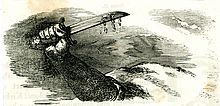Publisher Walker and Historian Frost
Among the most significant challenges associated with marketing Frost’s Pictorial History of the United States were those related to the financial relationships between publisher and historian. Like all publishers, Walker was interested in keeping the costs of production manageable, and he was keenly aware that illustrated histories took longer and were more expensive to produce. Frost believed that the returns on his literary work were not substantial enough given the effort he put into them, and, like many authors then and now, he felt at the mercy of publishers whose “greed, ruthlessness, and small heed to the fundamental decencies of civilized business relations” made writing a sometime unfulfilling pursuit. Publishers and writers, it seems, dealt badly with each other out of habit, with the publisher generally maintaining the upper hand.[21]
 Enlarge
Enlarge
In dealing with Walker, for instance, Frost had to make literary concessions to accommodate the publisher’s editorial and marketing strategies. Canvassing agents for Walker sold the history by subscription in unbound segments or “parts,” each of which were between 10 and 12 pages in length. (They were republished later in sturdier cloth editions of four volumes of exactly 240 pages each.) To capture a sufficient market share, publishers like Walker advertised the advantages of their popular works over those of competitors on the basis of the numbers of pages and words per page. This “history-by-the-pound approach” meant that Frost was forced to periodize the past in discrete units whose length was established not by him but by Walker, whose sensitivities to the proper apportioning of space were not always historically minded.[22] Many chapters in Frost’s Pictorial History of the United States end too abruptly (in mid-story, in some cases) or are stretched unnaturally in compliance with an ordering scheme that valued words per linear inch over narrative coherence. Walker added ornamental art at the beginning and end of truncated or elongated sections of Frost’s text (head-letter emblems and end-piece decorations) to smooth over physical breaks in the narrative, but these devices served mechanical bookmaking purposes more than literary or intellectual ones [Image 13].
Yet occasionally Frost had his way. The Pictorial History includes a disclaimer of partisanship that seems motivated by Walker’s desire to sell as many copies of the history to as wide an audience as possible. Frost states in the preface to the history that it would be “inexpedient to dwell upon disputed points, or to enter into extended disquisitions,” and he claimed to be “conscious of no undue bias towards any sect or party” in his narrative. And yet the text reveals a great deal of partisanship toward the Federalist cause and a strong anti-Jeffersonian tone. Frost could not resist remarking on the imprudence of the anti-federalists in attacking the policies of Washington in the 1790s, especially their assaults on Jay’s Treaty, and he supported the unpopular actions of John Adams in championing the infamous Alien and Sedition Acts. Not only did these points of view reflect negatively on the freedom of the press that publishers such as Walker valued, they revealed a suspicion of the masses for which Walker’s pictorial history was intended.[23]

